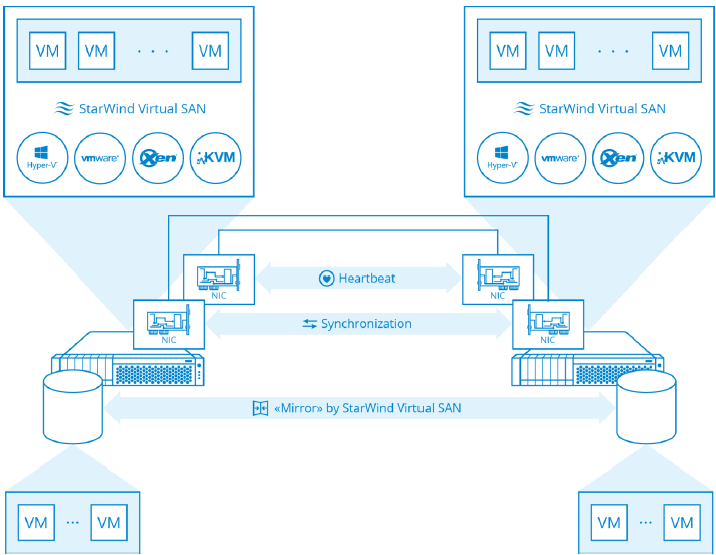Many businesses are adopting hypervisor platforms like Microsoft’s Hyper-V virtualization technology to reduce their server virtualization total cost of ownership. Small to medium sized businesses (SMBs) and corporations with multiple remote office locations, in particular, are leveraging the economies of scale in the form of lower licensing costs that Hyper-V can deliver. However, it requires an investment in some kind of shared storage solution to support seamless virtualization operations, like unscheduled virtual machine (VM) migrations and VM clustering for high availability.
Meeting these basic needs of an organization can inflate the TCO of a Hyper-V environment and reduce the return on investment in virtualization assets. StarWind Software’s Virtual SAN is designed to allow SMBs and remote offices to take full advantage of a Hyper-V environment without investing in an expensive dedicated shared storage architecture.
Software-Defined Inefficiencies
Software defined storage (SDS) solutions offer an alternative approach to traditional storage systems that in some cases can offset some of the capital costs required to deploy a dedicated storage array. SDS enables businesses to leverage lower cost server-side storage assets and pool them together across a VM cluster to provide disk resource sharing and to enable critical VM functions like clustering for high availability (HA) and live VM migrations between hosts.
The challenge is that some SDS offerings require a minimum of 3 hosts in a cluster before any of these operational benefits can be attained. This may mean an additional investment in server resources and hypervisor software licensing to support the SDS configuration. This three-host minimum is often overkill for many SMB and ROBO environments.
On its face, this may seem like a relatively minor issue, however, as the need arises to deploy additional clusters or if an enterprise is planning to deploy multiple systems in the field, the costs can quickly add up. Again, this can derail the Hyper-V value proposition and result in cost overruns.
SDS Square Peg?
Another challenge with some SDS offerings is that it introduces unneeded complexity into the data center. For example, some of these solutions require a VM running a Linux operating system to be installed on each host. Many environments that are considering Hyper-V as their virtualization platform are 100% Microsoft. Consequently, their IT personnel tend to be strictly focused on supporting Microsoft operating systems and applications. Introducing a second operating system into the environment requires administrators to develop some working level of knowledge of the new OS so that it can be adequately supported. Many businesses don’t have the budgets to send their admins to a Linux training class so often times admins will learn through on the job training on a production system, which introduces undue risk into the environment.
Moreover, running a separate VM on the Hypervisor to manage SDS functions may not be ideal since it can add a separate point of management. For example, if the Hypervisor is updated to a new release, the virtual administrator may have to upgrade each VM running the SDS software to ensure that it is compatible with the new version of the Hypervisor.
Lastly, some SDS solutions require a mix of flash and hard disk drives to be part of the shared storage pool. While flash capacity can provide a significant boost to application performance, it may not be required in some environments. Consequently, this could drive additional costs into the solution that provide no material benefit to the end-user.
Snap-in Hypervisor Integration
As a SDS solution that integrates directly into the Hyper-V or vSphere hypervisor, the Virtual SAN product does not require a separate VM to operate on the host and directly on the hypervisor. This simplifies the management and monitoring of the environment as virtual administrators can manage their entire virtual environment, VMs as well as their storage resources directly from the centralized hypervisor management interface. And since the software is Windows based, there is no secondary Linux operating system for administrators to manage – this is especially important for IT environments that are run entirely on Windows applications.
Implementation Efficiency
From an implementation perspective, StarWind Software’s solution can start out as small as a two node/host configuration and then be scaled-out as necessary to support additional VMs. Additionally, system planners can choose which internal storage resources they wish to deploy on the cluster – conventional hard disk drives (HDDs) or a combination of HDDs and solid state disk (SSD). The software then aggregates all the internal disk resources across the hypervisor cluster to make them available to any VM in the cluster.

By providing this level of implementation flexibility, the Virtual SAN offering can potentially save organizations significantly on the total cost of a virtualization deployment. For example, an SMB could start out with two modestly sized Windows hosts and populate each server with commodity HDDs to start sharing storage resources across all the VMs in the environment. There is no need to purchase a 3rd physical server with storage and the associated hypervisor software licenses. There is also no requirement to populate each host with expensive SSD resources.
Right-Sized Deployments
This allows businesses to install a server and storage architecture that best meets their virtual machine performance requirements. In other words, the infrastructure doesn’t have to be oversized in order to
meet the specification requirements of the SDS vendor. At the same time, the environment can be scaled up with additional HDD or SSD resources as storage capacity or performance requirements dictate. Likewise, additional hosts can be added to the hypervisor cluster to provide additional compute resources for scaling out more VMs into the environment.
In short, StarWind Software Virtual SAN solution is designed specifically to efficiently integrate and interoperate with Hyper-V environments and deliver on all the advanced capabilities of a shared storage solution without requiring excess computational, high-speed storage or new operating system software resources.
Non-Stop Operational Support
To ensure that data is always protected across the hypervisor cluster, Virtual SAN synchronously mirrors data and the cache across all the available disk resources in the cluster. The storage or virtual administrator can specifically designate how many replicas of a given VM they want to store across the shared storage pool. So a critical virtualized application may warrant triple redundancy while less critical system may only need 2 replicas. However, what is perhaps more important, all failover operations are fully automated in a Virtual SAN environment. If a host fails, the affected VMs are immediately brought back online, without any operator intervention, on an alternate host with zero data loss. This level of automated recovery is what organizations need to ensure non-disruptive business operations.
Intelligent Storage I/O
In order to maintain high storage I/O performance, Virtual SAN employs several techniques which help to ensure that data remains protected while affording the fastest possible storage I/O. First, the software has all the embedded caching intelligence to move hot data sets into the fastest available RAM and flash resources across the server cluster. Secondly, all read I/O requests are serviced up by the storage on the local host. This eliminates any added latency of going over the network to access data. To ensure data resiliency, only write I/O requests have to traverse the network. But even write I/O latency can be mitigated since the software can leverage a distributed RAM and flash cache across the cluster. So hot write data can be directed to very fast caching resources available across the cluster rather than slower, higher latency spinning disk drives.
And to further enhance the most efficient use of available caching resources, the Virtual SAN software utilizes space reduction technologies like compression and in-line data deduplication. The net effect is that businesses can pin more hot data to cache and actually get more life out of their flash resources.
The software can also intelligently migrate inactive data sets from expensive flash storage capacity to lower cost, high density disk drives. Interestingly, all of these efficiency capabilities make it possible for even SMBs with limited budgets to efficiently accelerate application performance. By deploying a small amount of flash, the Virtual SAN software will promote the right data sets into the available cache in the cluster and help ensure these resources are efficiently utilized and protected.
The Virtual SAN solution also supports offsite DR capabilities through asynchronous replication. System administrators can utilize Virtual SAN’s point-in-time snapshot data to replicate data offsite without impacting local application performance.
Maturity Counts
Most of the SDS solutions available on the market today are relatively newer offerings. While some technology suppliers have made significant investments in developing their technologies and running them at Beta sites for multiple months, in the end, nothing can replace product maturity.
StarWind Software’s, Virtual SAN solution has been delivering SDS technology to SMB’s and enterprise remote office locations for over a decade via their iSCSI based SAN technology. The StarWind Virtual SAN offering provides multiple operational benefits to Hyper-V deployments that help to maintain a low total cost of ownership, compared to other SDS solutions, while enhancing VM data availability, protection and application performance.
Conclusion
Many IT suppliers have laid claim to the idea that their solutions are “software defined”. Unfortunately, this had led to such an overuse of the term that it sometimes seems devoid of any real meaning. StarWind Virtual SAN technology, on the other hand, incorporates many of the attributes that constitute true software-defined storage.
First, by providing direct integration at the Hyper-V or vSphere hypervisor layer, Virtual SAN provides a simple and unobtrusive way to centrally and cohesively manage storage resources that are distributed across a virtualized server environment. Furthermore, businesses can start gaining all of the benefits of a shared storage solution for their virtualized environment by starting out in just a dual server configuration.
Secondly, by allowing storage planners to implement any form of commodity disk (hard disk drives and/or flash) as their shared virtualization storage pool, Virtual SAN allows organizations to deploy those storage resources which best fit their application performance and storage capacity requirements. This combined with support for a two-node configuration can enable businesses of any size and budget to start benefiting from infrastructure virtualization.
Lastly, by incorporating embedded advanced storage performance and management capabilities directly into the product, like advanced software caching, data tiering and storage efficiency technologies like in-line data deduplication and compression, Virtual SAN provides businesses with a lot of added value right “out-of-the-box” with a single storage software package. In fact, it is not unusual for many enterprise deployments to contain 2 or 3 different software products just to attain the same capabilities that Virtual SAN brings to the table.
In 2016, Gartner named StarWind “Cool Vendor for Compute Platforms”.
Gartner does not endorse any vendor, product or service depicted in its research publications, and does not advise technology users to select only those vendors with the highest ratings or other designation. Gartner research publications consist of the opinions of Gartner’s research organization and should not be construed as statements of fact. Gartner disclaims all warranties, expressed or implied, with respect to this research, including any warranties of merchantability or fitness for a particular purpose.


